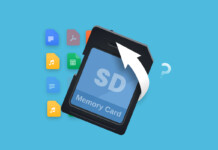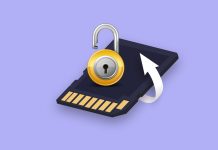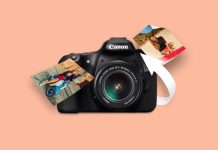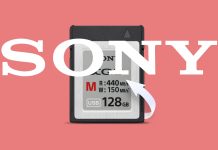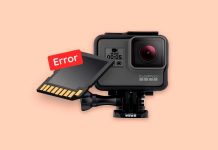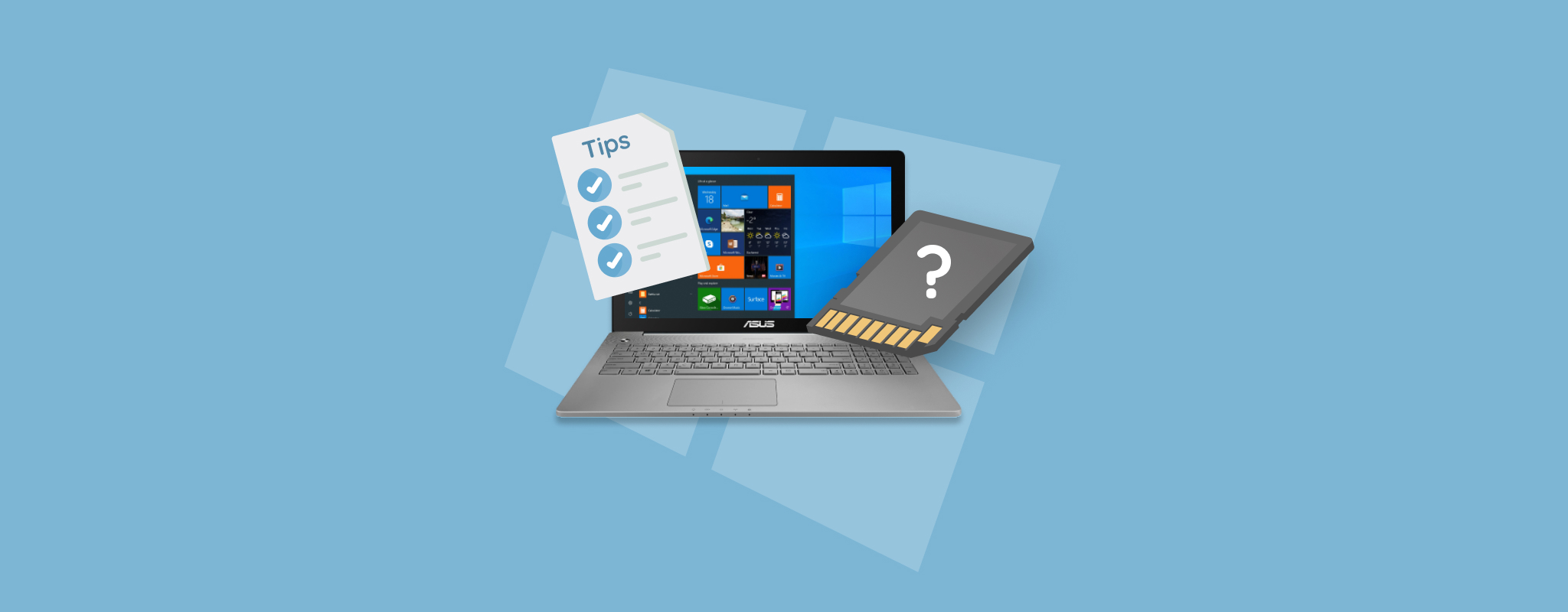
Have you tried to reinsert your SD card multiple times, but still wondering why your SD is not showing up on your Windows 10 or Windows 11 OS? If your computer doesn’t recognize the SD card or says “SD card not detected” after you insert it into the PC, there are a few easy fixes you can try.
However, before you try to access your SD card by applying fixes, it’s important to recover data on your SD card just to be safe. In this guide, you’ll learn how to recover data and fix your SD card within minutes.
Is It Possible to Fix SD Card that Is Not Detected?
The possibility of recovering an SD card that is not detected by your computer depends on the underlying reason why it became undetectable. This specific scenario will also determine how you can recover data from your SD card and how successful the recovery will be.
To shed light on this, let’s explore the different degrees to which your SD card can be undetectable:
- Your SD card is not detected in File Explorer but can be seen in Disk Management. In this scenario, you cannot access your SD card and its contents, but the drive is still recognized by your computer when you check for it via Disk Management.
- Your SD card is not detected in Disk Management but can be seen in Device Management. In this case, formatting your SD card might be extra challenging since Device Manager does not have the functionality to do this.
- SD Card is not detected in Device Manager. When your SD card cannot be detected even in Device Manager, it might mean that your storage device is physically damaged or dead. Fixing a dead SD card is extremely challenging, if not impossible.
Before troubleshooting your SD card, it’s also important to understand why your PC is not recognizing it. You can start with these common scenarios and the possible reasons behind them:
| Scenario | Possible reasons |
| 🔗 Your SD Card is not connected properly | Your SD card might not be fully inserted into the PC slot or card reader. In other cases, the slot or card reader is damaged. |
| 📚 Your SD Card reader is not working | This happens when your card reader’s hardware malfunctions or your drivers are outdated or corrupted. |
| 💻 Your SD Card has driver issues | SD card driver issues, such as outdated or corrupted drivers, can make your SD card undetectable to your PC. |
| 🗃️ Your SD Card file system is not compatible | Your computer will fail to recognize your SD card if it is formatted with an incompatible file system (e.g., inserting an NTFS-formatted SD card into a non-Windows computer) |
| 🔨 Your SD Card is physically damaged | Any damage to the physical components of your SD card will affect its performance or make it completely unreadable, corrupted, or unrecoverable. |
How to Recover Data from Unrecognized SD Card
If your SD card shows up in Disk Management with the correct size, you’ll be able to scan the card and possibly recover data from it. How successful data recovery is, however, will largely depend on the tool you use for recovery.
A smart and comprehensive tool like Disk Drill will give you the best chance to safely recover data from your SD card. We recommend recovering your files before fixing your SD card, as the methods to repair your device may require formatting.
Here’s how to recover data from SD card using Disk Drill:
- To get started, download Disk Drill and install it on your PC. You’ll be able to recover 500MB of data using the free version on Windows.
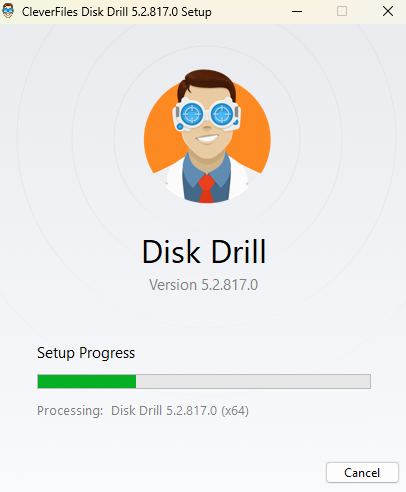
- Now, launch the Disk Drill app. You’ll see the list of devices you can scan on the home screen. Select your SD card from the list and click Search for lost data.
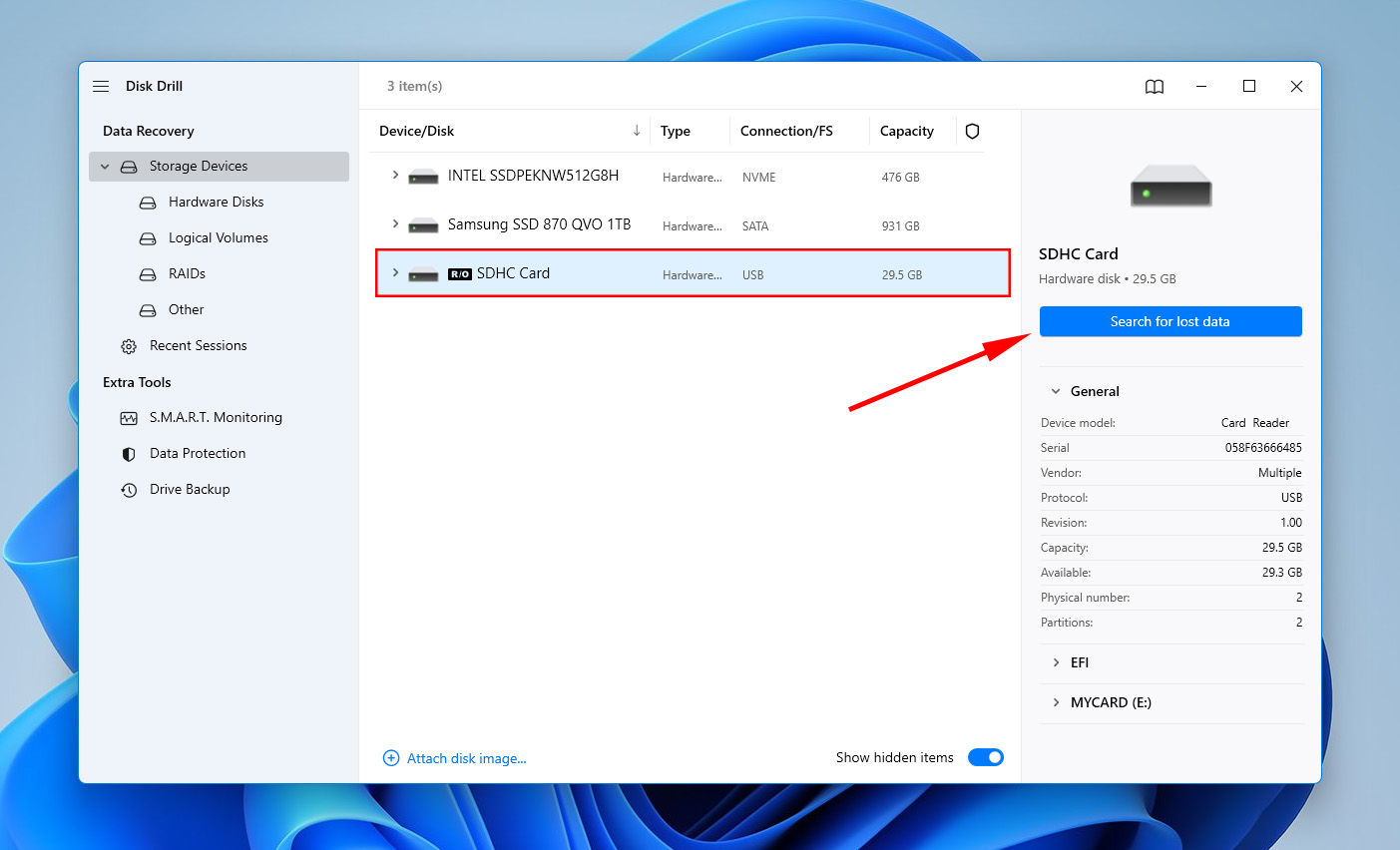
- Disk Drill displays the files it finds in real time as it scans your card. You can wait for the scan to finish first or view the scanned files immediately by clicking Review found items.
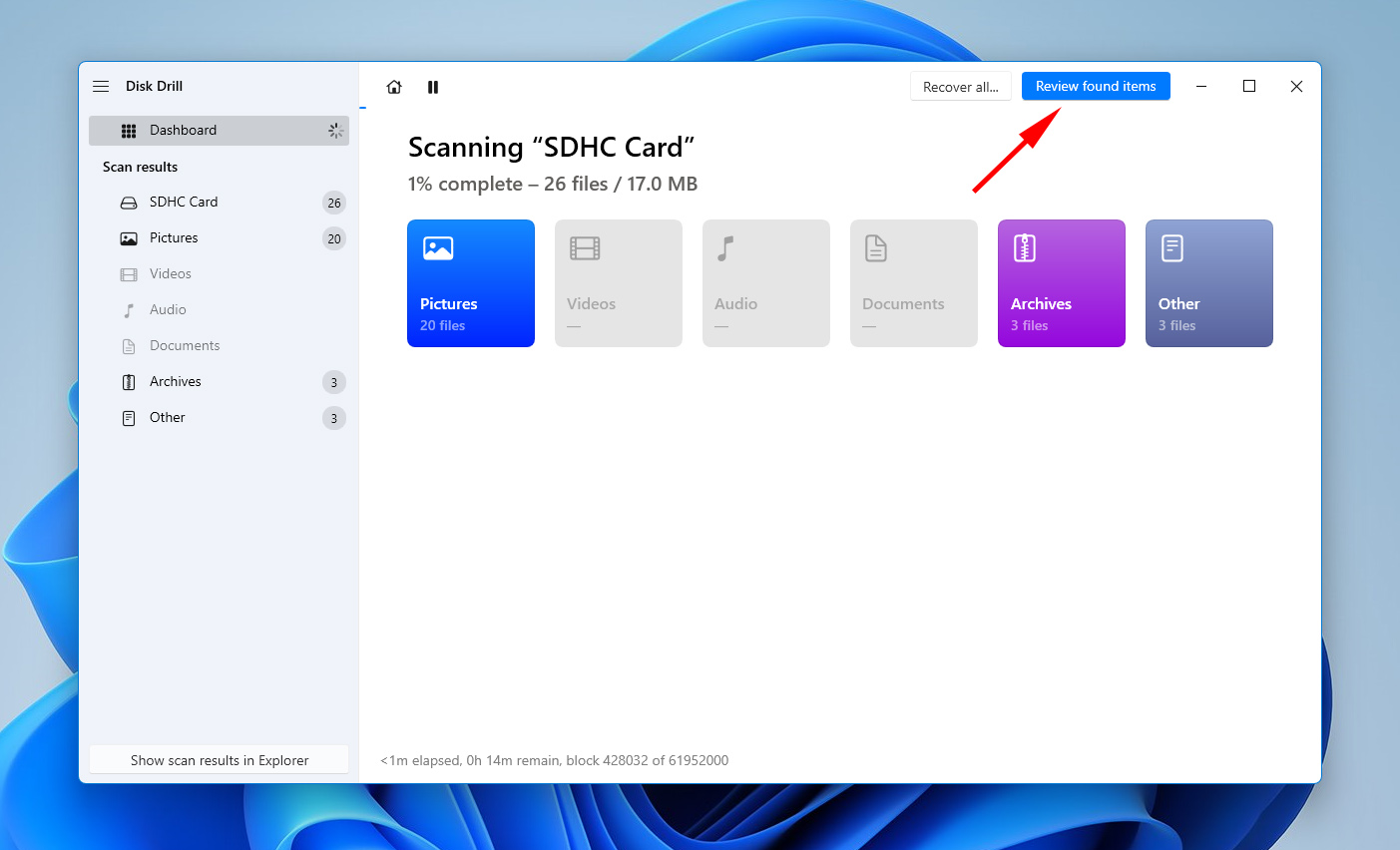
- Check the boxes next to the files you want to recover. Once you’re done selecting, click Recover.
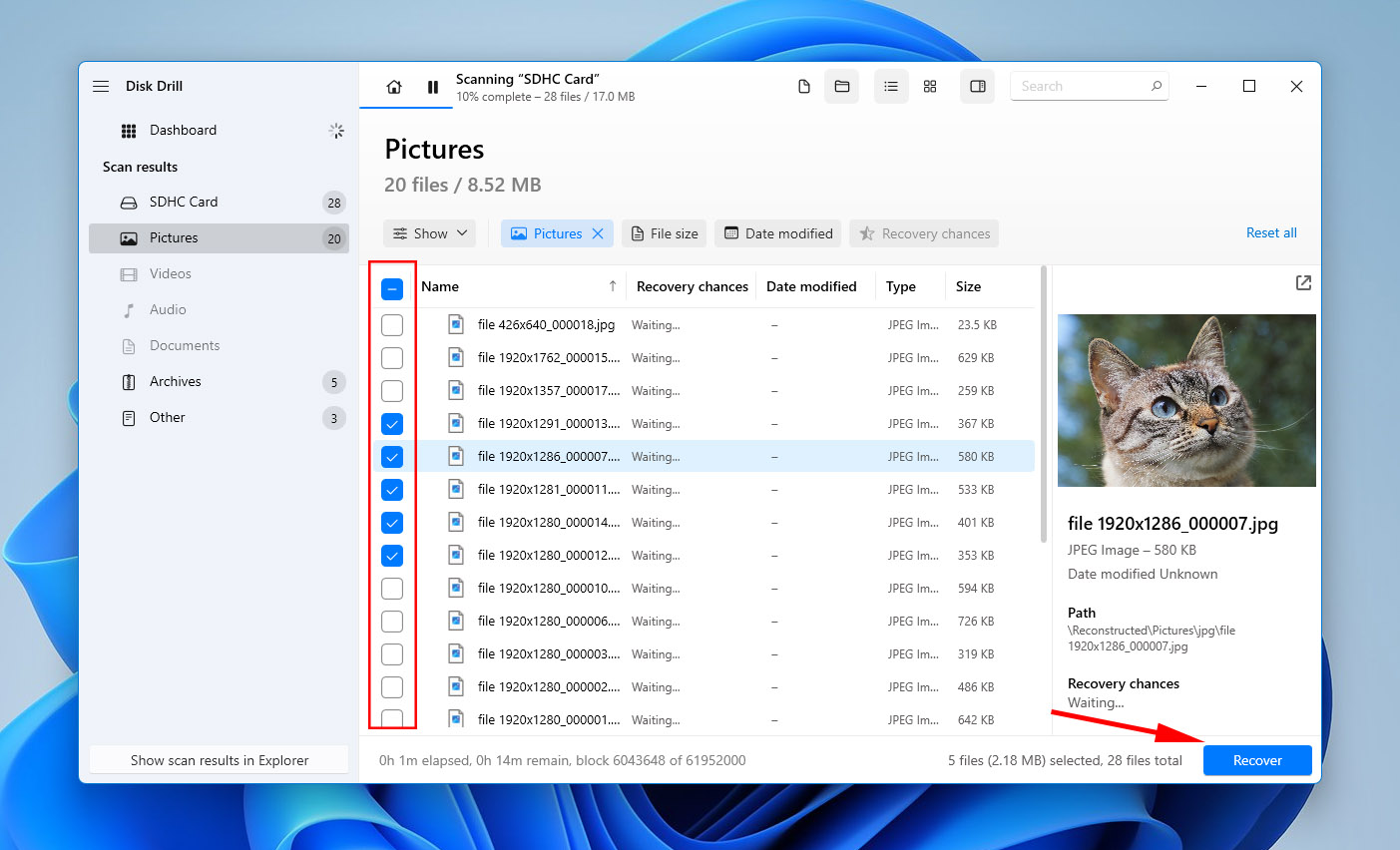
- Select the target location where you want to save your recovered files. Then, click Next to begin data recovery. It’s recommended to choose a different location from the one you’re recovering files from to avoid overwriting any data on your SD card.
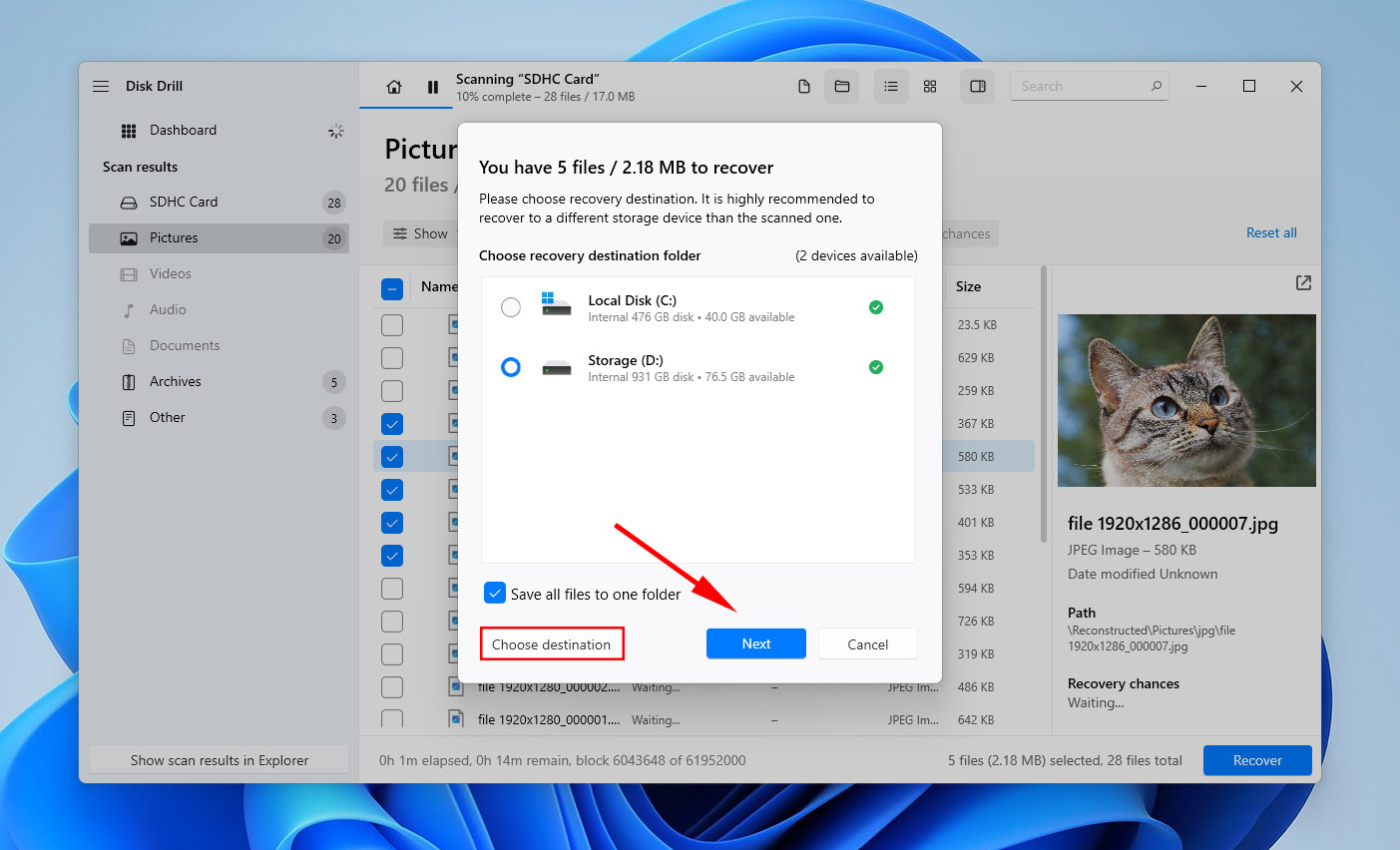
- Once data recovery is finished, Disk Drill will show you the results. Check out your recovered files by clicking Show recovered data in Explorer.
How to Fix SD Card That Won’t Read
Once you’ve recovered the files, you can start fixing your SD card. Your SD card may not show up on your Windows 10 computer for several reasons. Therefore, the fix depends on the cause. You can try to fix the problem in the following ways depending on what is causing the SD card to not show up:
Method 1: Check the Card Reader
Before you blame your SD card, check if your card reader is working properly. Try inserting a different card into the card reader and see if your PC detects the SD card and is able to read it properly.
If the other card doesn’t work either, clear any accumulated dust from the card reader. If cleaning the card reader doesn’t work either, plug the card reader into a different USB port to confirm if the card reader is functioning properly.
Method 2: Restart PC
As simple as it may sound, a restart might just fix your issue. Disconnect the card reader, restart your PC, and then plug it back in once your PC restarts.
Method 3:Disable and Enable the SD card Reader Device
Sometimes, just enabling and disabling the device does the trick. You can enable and disable the SD card reader from the Device Manager.
- Search for device manager in the Start Menu and open the Best Match.
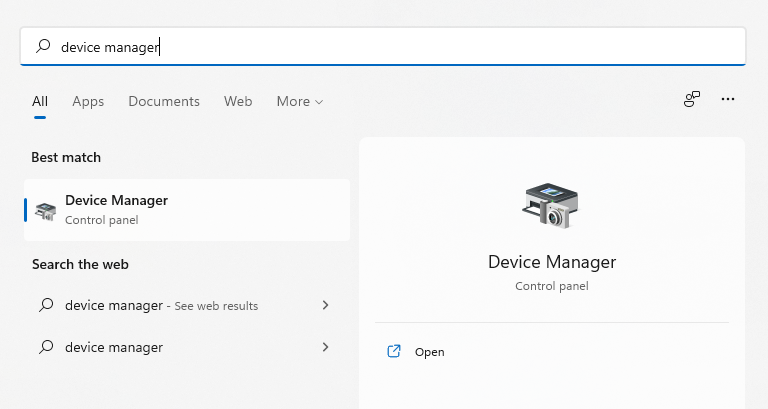
- Look for your SD card reader in the list of devices. It should be under Memory technology devices. If you don’t see this category on the list, click on the tiny arrow to the left of Disk drives. You’ll see your SD card under Disk Drives. Right-click on it and select Disable device.

- Next, right-click again and select Enable device.
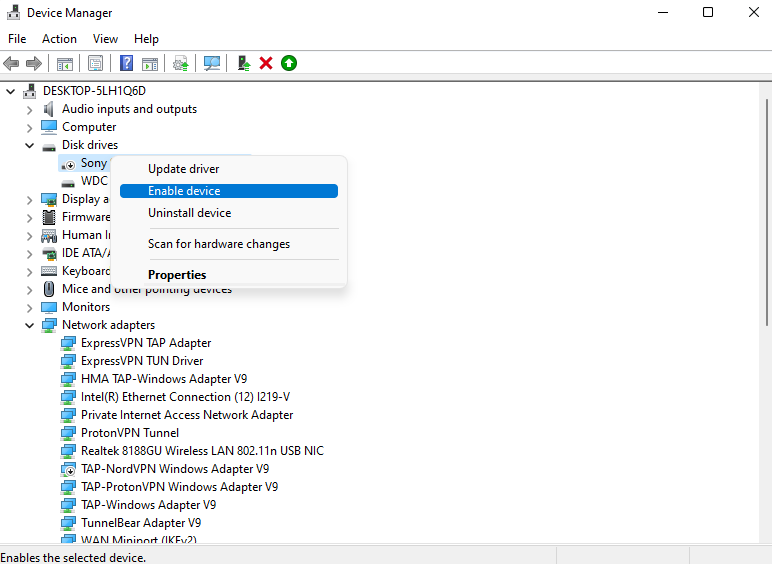
If this doesn’t fix the problem, try updating the drivers.
Method 4: Update Drivers
Windows almost always automatically installs drivers for all devices that you plug in. However, if the manufacturer has rolled out an update later to fix bugs, installing them can potentially fix your problem. You can use the built-in driver update feature in Windows, but if that doesn’t work, you’ll need to look through the manufacturer’s website to see if there’s a newer version of the driver and install it.
To try updating from within Windows, you’ll again need to use the Device Manager.
- Right-click on the SD card or SD card reader in the Device Manager and select Update driver.
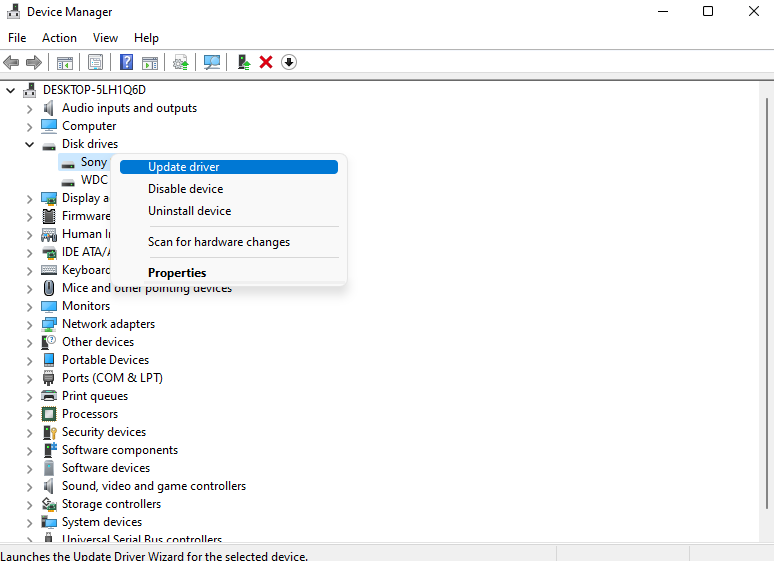
- Windows will ask if you want to search automatically for drivers or browse the computer for drivers. Select the first option.
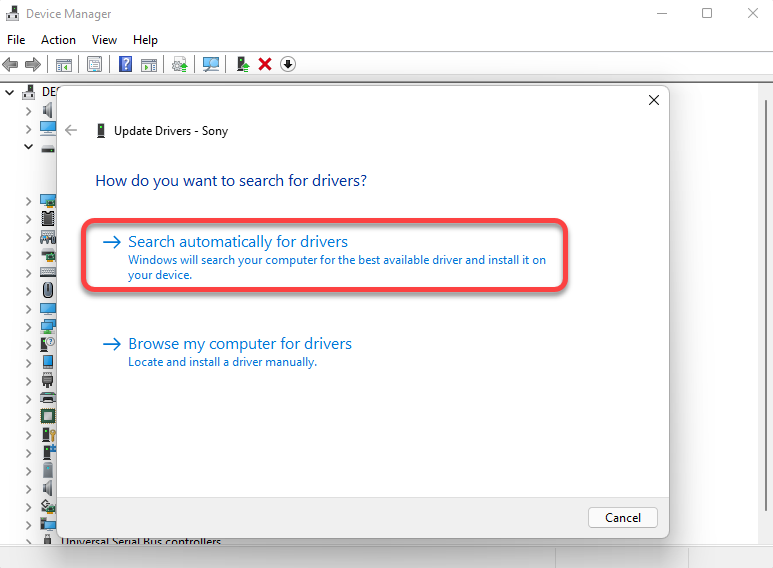
If Windows finds any updated drivers, it will install the drivers automatically. However, Windows isn’t that great at finding drivers. If it says the best driver is installed already, try looking through the manufacturer’s website for an updated driver.
Method 5: Format SD Card
Formatting is often the most foolproof option to fix an unreadable SD card, given that you can still see it in Disk Management. This process erases all the data from your card and resets its file system configuration, among other settings.
Here’s an easy guide to format your SD card:
- Open Open Disk Management by searching for disk management in the Start menu and selecting Create and format hard disk partitions.
- In the lower section of the program, you will see a list of all your connected devices. Locate your SD card. Then, right-click on it and choose Format.

- Follow the format instructions, selecting your preferred file system, card name, and format options. After that, click Start.
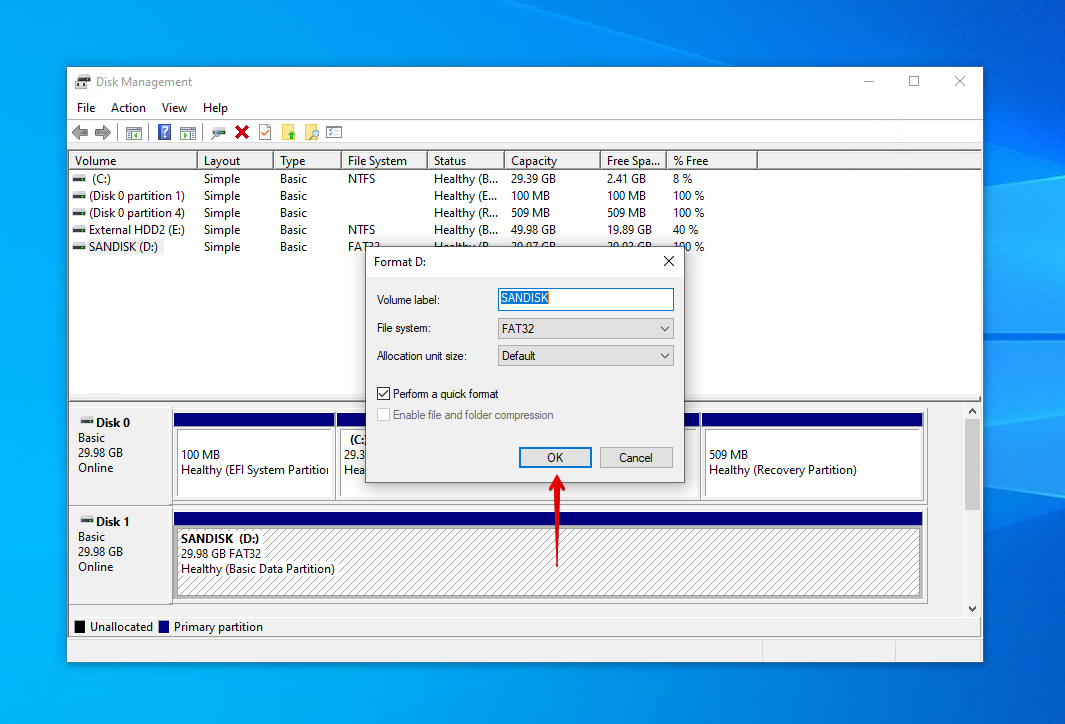
Method 6: Create Partition on SD Card
If your SD card can’t be recognized by your computer due to partition issues, you can try creating a partition to work around it. Follow these steps to create a partition on your SD card on Windows:
- Open Open Disk Management by searching for disk management in the Start menu and selecting Create and format hard disk partitions.
- Locate your SD card. Then, right-click on it and choose New Simple Volume from the menu.
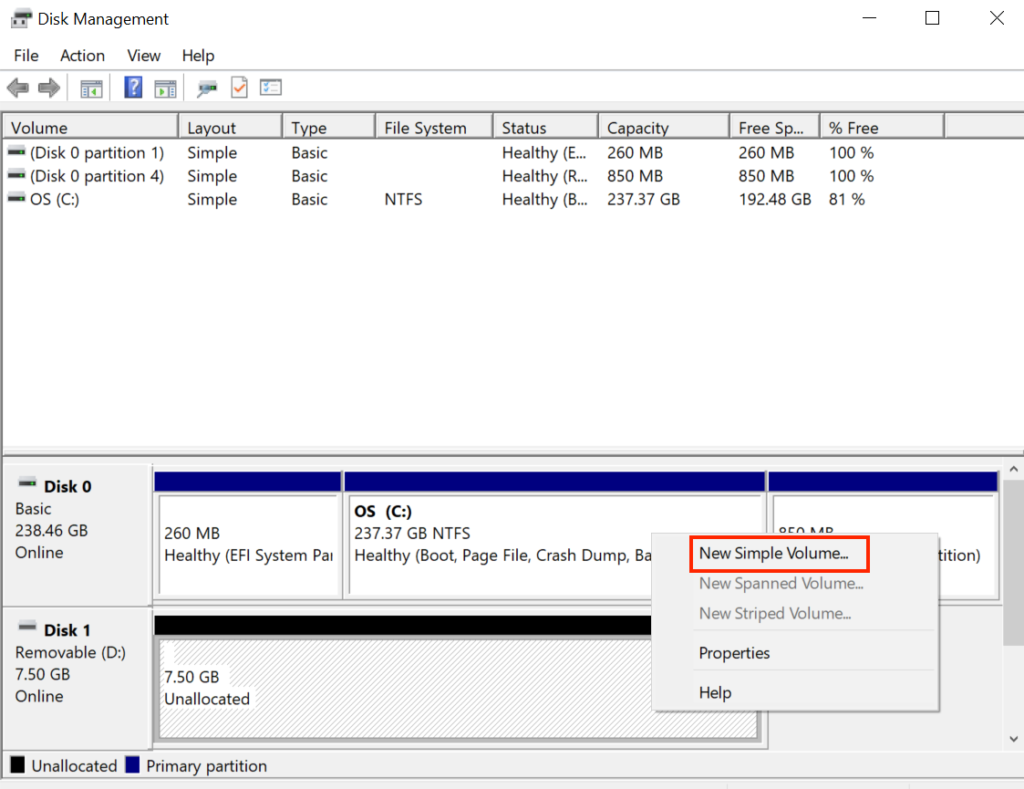
- On the wizard that opens, follow the instructions and set the partition size and drive letter to proceed.
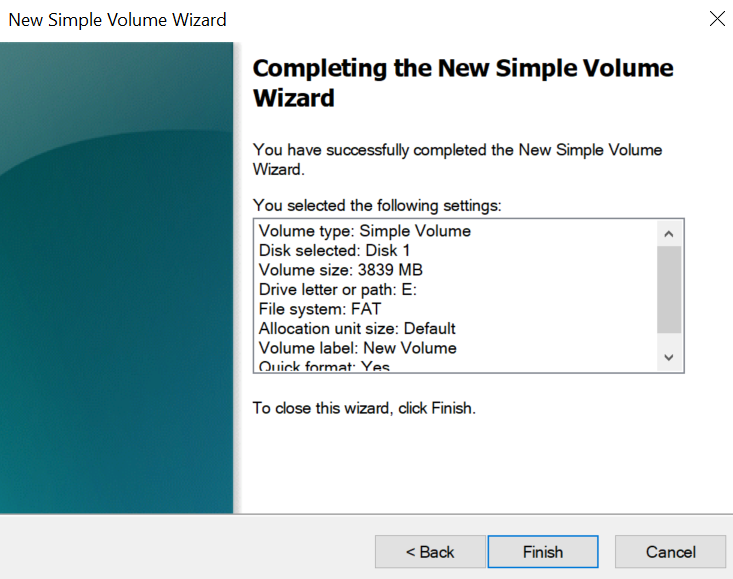
Method 7: Assign New Drive Letter
Sometimes, simply modifying your SD card’s drive letter can help your computer recognize your device. To assign a new drive letter for your card on Windows, follow these steps:
- Open Open Disk Management as discussed in previous methods
- Locate your SD card on the list of disks and partitions. Then right-click on it and select Change Drive Letter and Paths.
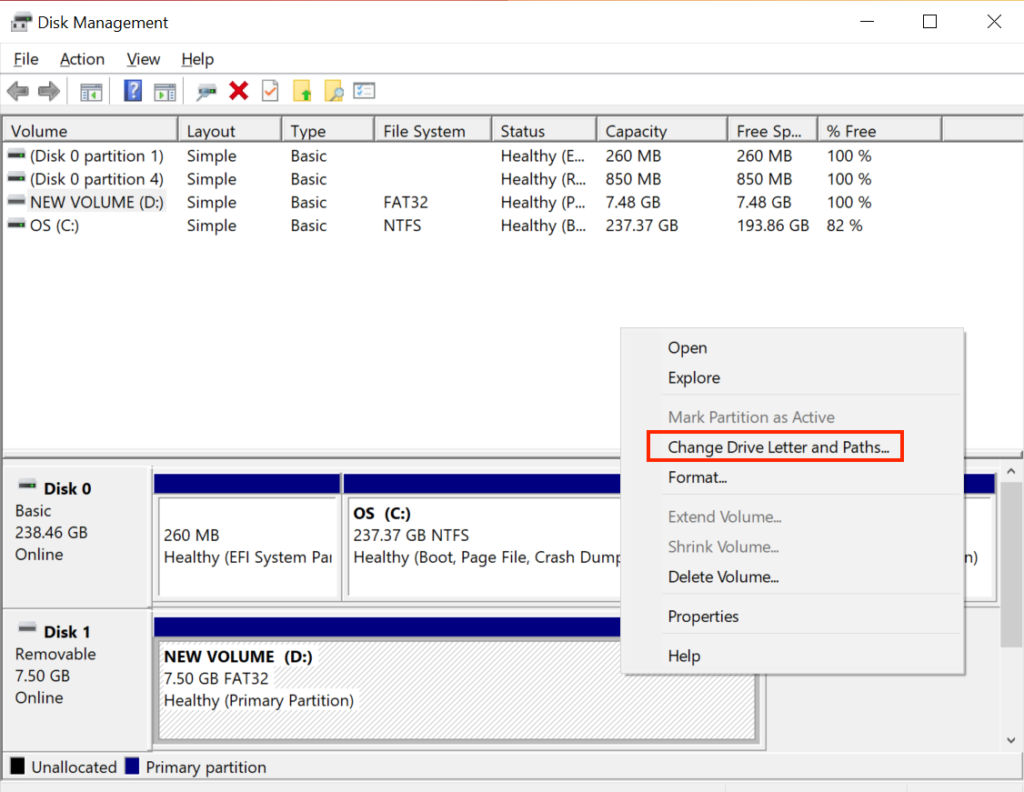
- Click Change. This opens another pop-up window where you can choose the drive letter.
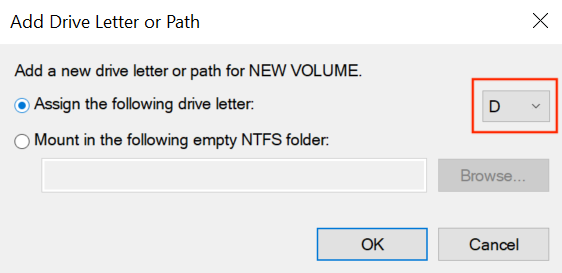
- Once selected, click OK.
After changing your drive letter, check if your computer can now recognize and access your SD card. If it remains unrecognizable, consider using the next method.
Method 8: Use CHKDSK to repair corruption
CHKDSK is a Windows utility that can scan and repair your SD card for file system errors. Follow these steps to attempt SD card repair with CHKDSK:
- Open Command Prompt by searching for Command Prompt on the Start menu and running it as administrator.
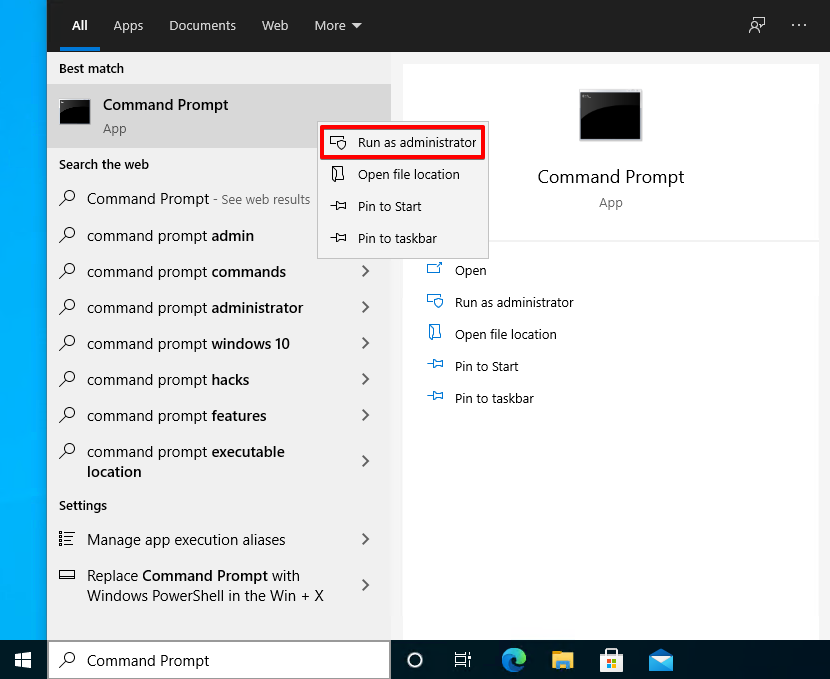
- Type
chkdsk N: /r /x, where N is the drive letter of your SD card. Then, press Enter.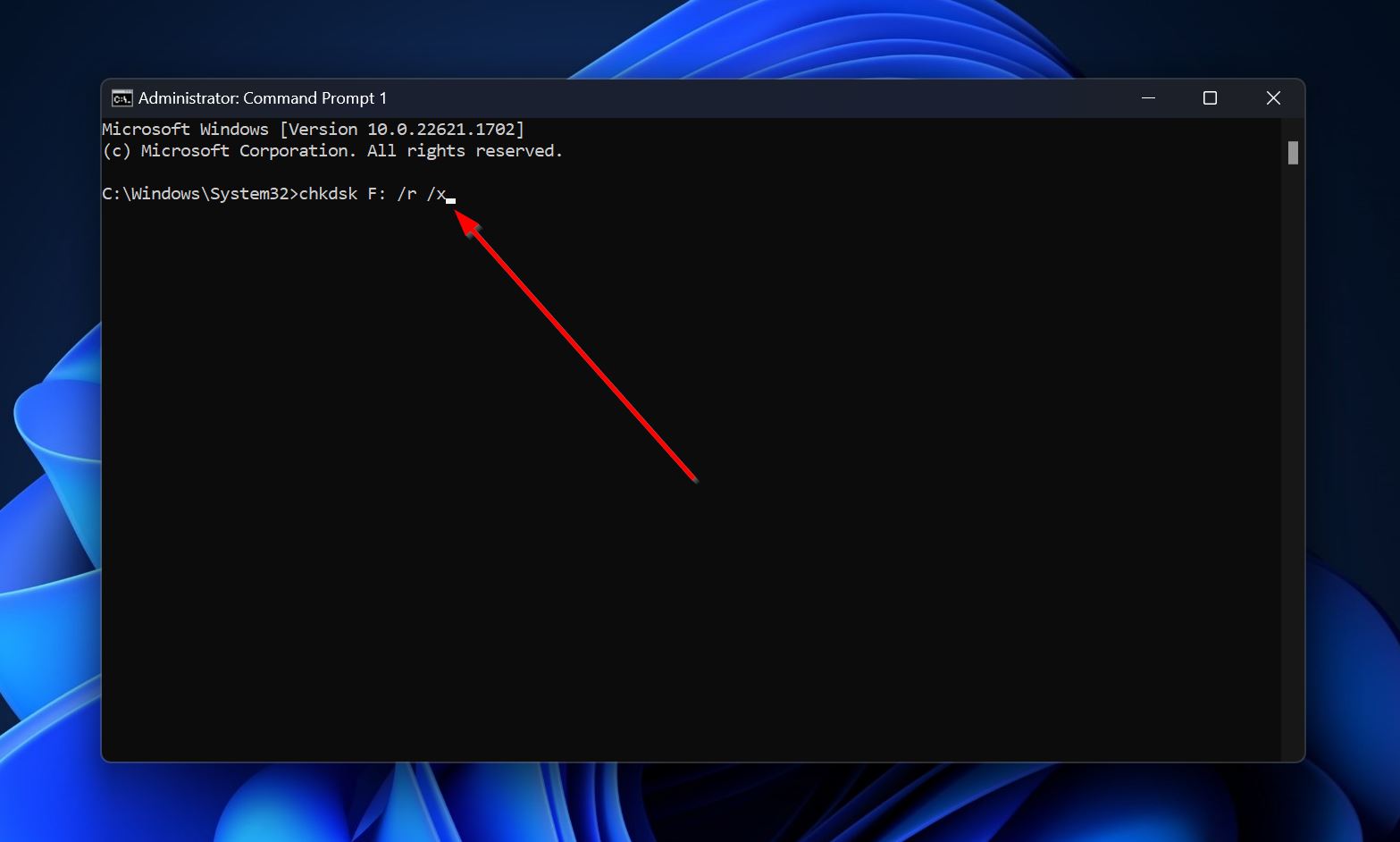
Wait for CHKDSK to scan and repair your SD card file system errors. The program will notify you once the process is complete. Eject and reinsert your card to check if your computer can now recognize it.
Conclusion
There are various reasons why your computer fails to recognize an SD card. Before attempting repairs, it is important to check for simple checks first, like verifying if your card reader or drivers are malfunctioning.
Just remember to choose the best data recovery software, like Disk Drill, to increase your chances of successfully retrieving your files. Then, use our comprehensive methods to fix your memory card without the risk of data loss.
FAQs
- The card has been physical damaged
- Built-in SD card slot in your phone has been damaged
- Dusty or dirty SD card slot
- SD card has been infected with a virus
- SD card has become corrupted
- Reinsert your card into the card reader/slot
- Restart your computer and reinsert your SD card
- Update your SD card drivers
- Disable and enable your SD card reader device from Device Manager
- Repair your SD card by running CHKDSK
